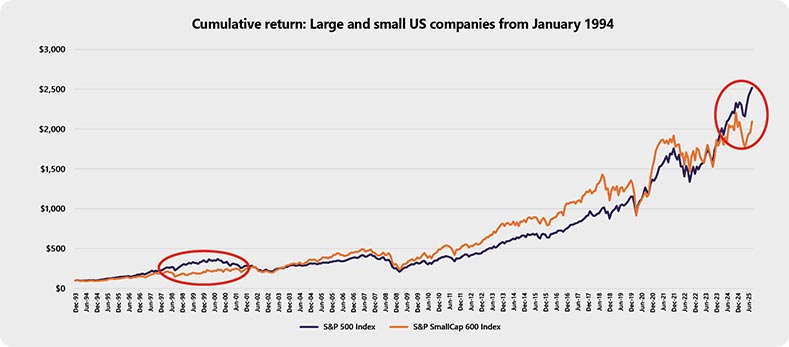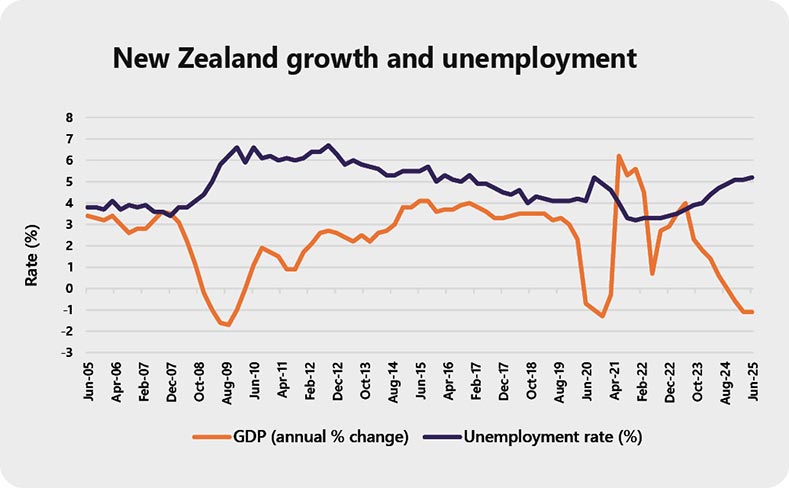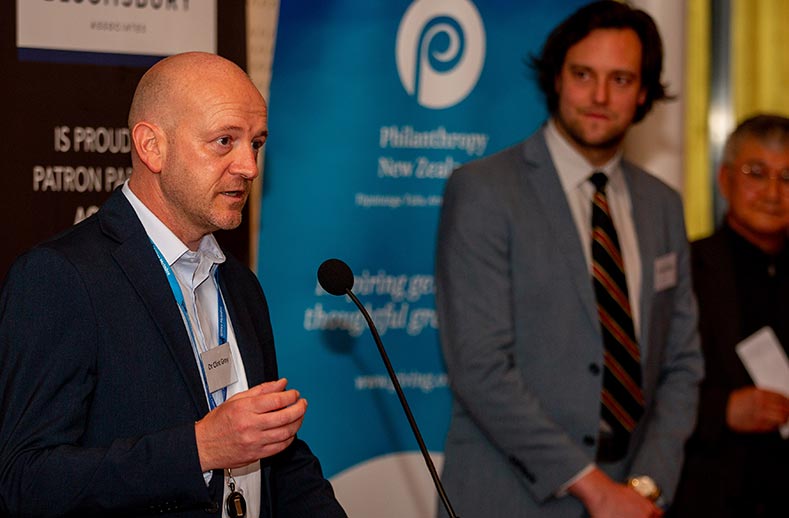
Bloomsbury Spring Update 2025 July - September 2025
In this issue
- Market commentary
- Key market movements for the quarter
- When money personalities collide
- Bloomsbury Associates White Paper
- Gillies McIndoe Research Institute
- Aotearoa New Zealand Festival of the Arts
- Like what you've read?
- Disclaimer
Market commentary
Global share markets continued to march higher during the third quarter of the year, contributing to strong returns for most diversified investors.
Markets were driven by several intersecting themes, including the interest rate easing expectations of central banks, a continuation of positive sentiment towards AI-related businesses, and intermittent political/regulatory risks.
By September, the US Federal Reserve delivered its first 0.25% cut to US interest rates in this cycle (opening a path for further reductions), which pushed global bond yields lower and lifted bond prices. This also contributed to increased volatility as markets debated the timing and depth of future rate cuts.
Information technology and communication services were the leading US equity sectors for the quarter, driven by strong returns from high-profile mega cap companies like the microchip behemoth Nvidia and Google's parent company, Alphabet.
Political and regulatory 'noise' included a US government funding impasse and ongoing geopolitical tensions which, on headline days, served to boost demand for safe-haven assets while trimming broader risk appetites.
However, despite a backdrop of slower growth and ongoing trade/tariff uncertainties, investors who weathered the volatility and stayed invested were generally well rewarded.

Recency bias
The last few years have been noteworthy for the strong returns coming from a few mega cap firms in the US share market (such as Nvidia, Microsoft and Apple). With financial commentators devoting more column inches to these large and high-profile firms, investors could be forgiven for thinking they are the only firms that matter. Unfortunately, that creates a breeding ground for a condition known as 'recency bias'.
This is a cognitive bias that favours recent events over historic ones. It often manifests when we identify what appear to be strong price trends (either up or down) in selected companies, or an entire market, often over the short term. It convinces us that rising prices will continue to appreciate, or that declining prices are likely to keep falling.
Recency bias often leads us to make emotionally charged choices - such as holding shares for too long (when prices have risen), or selling out too soon (when prices have fallen). These kinds of decisions may feel right at the time, but often end up eroding our long-term investment performance.
To provide some context around this, the chart below shows the cumulative return of two different US share indexes going back to the beginning of 1994 - the S&P 500 (Large cap index, in purple) and the S&P SmallCap 600 (Small cap index, in orange)1.
Cumulative return: Large and small US companies from January 1994

See larger version of this image
It might come as a surprise to see that, apart from the two periods highlighted in red, the cumulative return of small US companies has generally been superior to large US companies (including the high-profile mega cap companies referred to earlier).
The first highlighted period, starting in the late 1990s, was the tail-end of the now infamous dot.com bubble, where many large firms became significantly overvalued on the idea that the internet was going to change the world.
The internet did change the world, but many unrealistic company valuations went from sky-high to cents in the dollar (or in some cases to zero) as investors eventually returned to fundamental valuation metrics linked to sales revenue, growth and profits.
The second highlighted period is the last three years where a cohort of mega cap companies have outperformed the wider market, spurred along by further advances in technology and, in particular, developments in artificial intelligence (AI).
This is not a prediction that AI related businesses today are about to suddenly underperform as they did following the dot.com crash. It is simply a reminder that the recent outperformance of the large cap segment of the US market is far from the norm that our recency-biased minds might have assumed.
New Zealand economy poised for better
In August, the Reserve Bank of New Zealand (RBNZ) cut the Official Cash Rate (OCR) by 0.25% to 3.00% and followed this with a further 0.50% cut to 2.50% on 8 October, marking a low not seen in more than three years.
While global uncertainty was a contributing factor, the RBNZ noted across the two announcements that growth in the New Zealand economy had stalled, with cautious behaviour by households and businesses being mirrored by a soft labour market.
This is evidenced in the chart below showing the New Zealand growth rate (measured by annual Gross Domestic Product) and our associated unemployment rate over the last 20 years. It tells an interesting story.
New Zealand growth and unemployment

See larger version of this image
Twenty years ago, economic growth in New Zealand was fairly steady at around 3% and unemployment was low at just under 4%. Then, without much warning, we were confronted with the Global Financial Crisis (GFC) in 2008/2009 and, as per the chart, its impact on New Zealand's growth and unemployment is unmistakeable.
The GFC triggered the deepest global downturn since the 1930's. Economies contracted, international trade declined and millions of people around the world lost their jobs. New Zealand was not immune from these shockwaves. Over the 2008/2009 period, the country's unemployment rate increased to near 7% and our growth rate plummeted, with the economy contracting close to -2% in the year to 30 September 2009.
After spending the next 10 or 11 years gradually improving our economic growth and with unemployment easing back down to 4% again, in early 2020 the world was confronted with another unforeseen crisis - Covid-19.
And look at what happened. Growth in New Zealand has been highly unstable ever since. This was initially due to lockdowns and border closures, and more recently due to our struggle to adapt to the much higher interest rates that were implemented after inflation spiked to levels not seen since the 1980's. In the midst of a more difficult growth environment, New Zealand's unemployment rate also moved back above 5%.
While the economy is struggling to get back to a more sustainable growth track, lower interest rates offer some hope that the headwinds facing local businesses may be starting to ease.
Since July 2024, the OCR has fallen from 5.5% to 2.5%, and in its 8 October announcement the RBNZ indicated it remains open to further reductions in future if conditions require it. At these much lower levels, we can reasonably expect lower financing costs to be a boost to New Zealand business activity, which would eventually flow through into higher growth and lower unemployment.
While the economy has faced a few challenging years since the arrival of Covid, the outlook ahead looks rather more positive.
The Trump tariffs - what's new?
It's too big a topic to write about in detail, but it's also too important to ignore.
One of the key policy issues hanging over markets continues to be the uncertain rollout of tariffs by the US. Although details remain fluid, it seems clear that the US is currently committed to adopting more aggressive trade protectionism. Their preferred approach has been to impose higher baseline tariffs, expanding country-specific tariffs, and reducing prior exemptions (such as the former de minimis rule that exempted tariffs on parcels worth less than USD 800).
Adding to the confusion is that tariffs are not just being spruiked for trade or economic protection reasons. They have also been trumpeted as a tool for promoting national security, greater border control, and even as a bargaining chip in geopolitical negotiations. While there isn't much historical evidence supporting some of these claims, that's not slowing down the Trump administration, which is relentlessly pressing ahead with its strategy.
However, regardless of the rationale, tariffs are slowly starting to result in increased costs for US supply chains and consumers, and some US industries are warning that higher input costs and inflation will lead to reduced competitiveness.
This tug-of-war between the tariff virtues being extolled by the Trump administration versus the real-world impact on consumer prices and supply chains may become a central issue in the run-up to the 2026 US mid-term elections on 3 November. If, by then, US consumers are still not seeing or feeling the benefits of these policies, there will be an opportunity for them to record their frustration at the ballot box.
The other fascinating aspect of this is that, on 30 August, a US appeals court ruled that most of the tariffs were illegal. Regardless, they allowed the tariffs to remain in place to give the Trump administration a chance to appeal to the US Supreme Court. The Supreme Court has subsequently granted a review and is scheduled to hear arguments in November.
As the centrepiece of the Trump administration's entire economic policy agenda, this appeal will be watched intently around the globe, where questions about the legality of the tariffs and the degree of independence of the US Supreme Court, will potentially all be answered at once.

The pros and cons of safe haven assets
A safe haven asset is an investment that investors are attracted to during times of market stress, or crisis, because it is expected to hold its value or even increase in value while riskier assets (like shares) might fall.
Key characteristics of such assets are:
- They are easily understood and not reliant on a single market
- Their value is stable or declines far less than other assets in downturns
- They are easy to sell, even in stressed markets
The ultimate safe haven asset is probably cash, at least for short periods, as it is a very low risk asset and doesn't move in harmony with other assets. However, holding cash for long periods introduces an exposure to inflation risk.
Another traditional safe haven asset is US Treasury bonds or the US dollar. Often, when investors have sought shelter from stressed share markets, bonds issued by the US government are almost always highly sought after, due to the US's strong creditworthiness and the US dollar's role as global reserve currency.
The other safe haven asset that most people think of is gold. Its supply is limited, it's globally accepted and its value is not tied to any government.
The problem with safe haven assets is not so much knowing what they are, it's thinking that we can usefully time our entry into and out of them.
Buying a safe haven asset when times are tough is more likely to be a bad idea than a good one. Often a trade like this is considered when markets have already fallen to the point that investors don't feel they can tolerate staying invested any longer. Unfortunately, that frequently results in investors selling assets at a discount (ie when their expected future returns have risen significantly).
Then, in order to one day leave the safe haven asset and move back into risky assets, investors who were spooked on the way down are likely to want to see clear evidence that the markets are recovering. And, you guessed it, that tends to result in investors buying assets back after their prices have already gone up.
The aggregate effect is that an investor is likely to be worse off than if they had simply held on to their well-diversified portfolio of risky assets in the first place.
Investors also need to be aware that, in spite of their name, safe haven assets aren't always true to label and can also experience a decline in value for periods of time. Sometimes that can even coincide with the stressed market conditions that investors are seeking to avoid.
With many share markets currently cresting all-time highs, safe haven assets aren't getting much media attention. However, when that inevitably changes sometime in the future, just remember that sticking to a well-diversified, long term plan is quite often the best decision of all.

Final thoughts
If someone was able to tell you that over the next 20 years global shares would go up in over 75% of calendar quarters (three-monthly blocks) while delivering a compound annual return of 9.7%pa over the full period, your response should be only four words - "where do I sign?!".
What's notable about those numbers is that this has been the actual performance of global shares hedged to the NZ dollar over the last 20 years despite recessions, geopolitical conflict, wars, a global financial crisis and a global pandemic. That should say something reassuring about the propensity for innovation, risk taking and capitalism to be extremely well rewarded over long time periods.
And, as shares form the growth engine of most traditional long term investment plans, that level of return goes a long way to helping all investors achieve their long term planning goals.
Unforeseen life changes will inevitably occur, so adapting a plan to new information is always a good idea. But, otherwise, less is more. Maintaining good disciplines, avoiding investment fads, and resisting behavioural urges to take more (or less) risk as market conditions change, will all help propel you to your desired investment destination.
We don't know what the future holds, but we can know with certainty that the next 20 years will be full of news that we didn't expect. Some of it is likely to genuinely concern us when it happens. However, as in the last 20 years, we have every reason to expect that markets and patient investors will continue to win out in the end.
Footnote
- Within the largest 1,500 companies in the US, the S&P 500 captures the returns of the 500 largest firms, while the S&P SmallCap 600 captures the returns of firms ranked 901 to 1,500, by size.
Key market movements for the quarter
International shares
Developed markets posted robust returns underpinned by strength in the technology sector, easing monetary policy and progress on US trade deals.
US markets continued to climb, with easing monetary policy and strong corporate earnings improving sentiment toward risky assets, evidenced by small, momentum and growth factors outperforming throughout the quarter. Gains were concentrated in the Information Technology and Communication Services sectors, underscoring the impact of the AI boom on the equity market. Economic data releases were also constructive for markets, with second quarter GDP revised higher and strong consumer spending through the September quarter. Progress on trade deals through August further strengthened sentiment.
The Japanese share market posted double digit gains, propelled by structural reform and growing confidence in an earnings recovery. Cyclical sectors outperformed, while materials, energy and semiconductor shares benefited from the global AI boom.
European equities made gains through the quarter, though lagged the broader market. Germany and France dominated headlines. A -0.3% contraction in German GDP sparked recession fears and weak earnings from automakers Volkswagen and Porsche further weighed on the DAX, leaving it as the only major index to post a negative quarter. France experienced ongoing political instability, Prime Minister Lecornu replaced Bayrou after a no confidence vote in September, before resigning in early October and being reappointed four days later. The UK outpaced its European peers over the quarter, driven by stock-specific developments in the Healthcare and Defence sectors.
Source: MSCI World ex-Australia Index (net div.)
Emerging markets shares
Emerging markets (EM) shares had an outstanding quarter, with several key markets delivering over +20% returns. Gains in emerging markets were primarily driven by a weak US dollar, which boosts EM export competitiveness, eases debt burdens and encourages capital flows. Positive investor sentiment around the globe in relation to the AI boom and interest rate cuts from the US Federal Reserve also contributed to EM gains.
Chinese markets roared higher, supported by a weaker USD and positive sentiment. China's outperformance against the rest of the emerging markets was driven by progress in US-China trade talks, with China offering a USD 1 trillion investment in an attempt to reset US-China trade policies. Structural policy changes designed to combat deflation and continued stimulus measures have also contributed to optimism for the Chinese economy.
India was a notable laggard, one of the only major emerging markets to post a negative quarter. Ongoing concerns over the valuation of the equity market and weaker corporate earnings set the stage for a weak quarter, and the imposition of a 50% tariff by the US on key Indian exports sealed the deal. India has failed to make the same progress on trade deals with the US as other countries.
South Korea and Taiwan both posted strong gains, primarily driven by ongoing strength in the technology sector and the continuation of the AI boom. South Africa doesn't often feature in our economic commentary, however its place in the +20% club this quarter warrants acknowledgement. Gains were driven by strong precious metal prices.
Latin American equities posted a strong quarter in aggregate, with the S&P Latin America BMI up +9.5%, however results from individual markets within the region were mixed. The largest markets in the region - Brazil, Mexico and Chile all delivered robust gains, with benchmark indices up +5.0%, +10.0% and +9.0% respectively. Colombia also posted circa +10% returns while Argentina was a significant outlier, with the S&P MERVAL Index falling -11.1%. Latin America was primarily driven by the same factors driving global markets - trade agreements and positive risk sentiment, however lagged the rest of EM due to political uncertainty.
Source: MSCI Emerging Markets Index (gross div.)
New Zealand shares
New Zealand shares moved higher in the third quarter. The NZX 50 Index posted its second-best quarterly result since December 2020 and the index closed the quarter just below its 2021 all-time highs despite a challenging economic environment.
Local markets benefitted from a more positive global economic outlook, tied to progress on US trade deals and better global growth prospects. The supportive stance from the Reserve Bank of New Zealand (RBNZ), which followed a -0.25% rate cut in August (and an emergency -0.50% rate cut in early October), also buoyed the market. However, share price gains in New Zealand were ultimately limited by lower domestic growth estimates and weakening business confidence.
Small companies significantly outperformed the broad New Zealand market, with the S&P/NZX Small Cap Index up +18.5% for the quarter. Small companies are disproportionately impacted by interest rate changes, so 0.75% of rate cuts and more supportive rhetoric from the RBNZ drove a wedge between the performance of the Small Cap Index versus the broad market.
Heartland Group and Vulcan Steel led the NZX 50 Index this quarter, both up over +30%. Heartland has been rallying since its earnings outlook announcement in August. Other winners include Fonterra, Freightways Group, Stride Property and Channel Infrastructure, all up over +20%. On the other side of the ledger, SkyCity and Ebos Group both fell over -20% through the quarter.
Source: S&P/NZX 50 Index (gross with imputation credits)
Australian shares
The Australian share market underperformed global equities, posting a +4.7% gain in local currency terms. Small and mid-capitalisation companies outperformed significantly, with the S&P/ASX Small Ordinaries delivering +15.3% and the Emerging Companies Index posting a remarkable +29.6% gain. This can largely be attributed to the higher weight of technology companies in the Australian small and mid-capitalisation indices, which have been performing well, in line with global technology shares.
Monthly inflation estimates came in much higher than expected, rising from +1.9% year-on-year in June to +3.0% in August. Despite promising signs in global trade, consumer spending and the labour market, there is still significant uncertainty in these areas. There is also risk that the lagged effects of monetary easing could impact the persistence of consumption growth. This uncertainty, paired with elevated inflation led the Reserve Bank of Australia (RBA) to pause interest rate cuts, which the market took as a sign that further cuts were unlikely for the foreseeable future.
Materials, Utilities and Consumer Discretionary led the Australian market, all up double digits for the quarter. Healthcare fell -9.3% while the rest of the market was relatively flat.
In the top 50 ASX listed companies, Lynas Rare Earths was up over +100% driven by rising rare earth metal prices and efforts to diversify the rare earth supply chain away from China. Life360 also had a fantastic quarter, up +65.4% driven by strong earnings and a new partnership with AccuWeather.
With the Australian dollar significantly stronger against the New Zealand dollar over the quarter, the reported returns to New Zealand investors were circa +6% higher than the reported index returns.
Source: S&P/ASX 200 Index (total return)
International fixed interest
Yields across major markets were mixed, with US 10 Year Treasury yields falling from 4.23% to 4.15% while yields in other major markets such as Australia, Europe and Japan all rose over the period.
In the US, the balance of risks switched from upside inflation risk to downside growth risk. While inflation rose to +2.9% from April's low of +2.4%, the three months to August saw average monthly job gains fall to 29,000, down from 99,000 in the three months to May. As more data was released throughout the quarter, it became evident that the US economy may not be as robust as previously thought. The market had almost completely priced in a rate reduction from the Federal Reserve by the time the Federal Open Market Committee announced its -0.25% cut at the September meeting.
Evidence that Germany's defence and infrastructure spending would primarily benefit the domestic European economy and progress on tariff deals with the US led to an improvement in sentiment through Europe. Better growth prospects and confidence in risk assets led to an increase in yields across major economies. France lagged the rest of Europe amid ongoing political turmoil, and Fitch downgraded the nation's government bonds from AA- to A+ citing 'political fragmentation' and a 'weak fiscal record'.
The FTSE World Government Bond Index 1-5 Years (hedged to NZD) was up +0.7% over the quarter, while the broader Bloomberg Global Aggregate Bond Index (hedged to NZD) rose +0.9%.
Source: FTSE World Government Bond Index 1-5 Years (hedged to NZD)
New Zealand fixed interest
The RBNZ delivered another -0.25% interest rate cut in August (plus a further -0.50% reduction on 8 October), highlighting the continued economic challenges facing New Zealand.
Lower than expected growth, weakening business confidence and wage growth failing to catch up with CPI inflation over the past several years continue to weigh on the New Zealand economy. The key focus for the RBNZ remains on global and domestic growth fears, as the New Zealand economy's recovery continues to move slowly, and US trade protectionist policies raise additional risks from abroad.
On the back of a mixed global bond market, the New Zealand 10-year bond yield was up for the quarter, moving from +4.48% to +4.67%.
The S&P/NZX A-Grade Corporate Bond Index gained +2.9% for the quarter, while the longer duration but higher quality S&P/NZX NZ Government Bond Index gained +0.8%.
Source: S&P/NZX A-Grade Corporate Bond Index
Table 1: Asset class returns to 30 September 2025
| Asset class | Index name | 3 months | 1 year | 3 years | 5 years | 10 years |
|---|---|---|---|---|---|---|
| International shares | MSCI World ex Australia Index (net div., hedged to NZD) | 7.5% | 16.7% | 22.5% | 14.3% | 12.5% |
| International shares | MSCI World ex Australia Index (net div.) | 12.9% | 28.8% | 22.4% | 17.5% | 13.6% |
| Emerging markets shares | MSCI Emerging Markets Index (gross div.) | 16.6% | 29.5% | 17.4% | 10.4% | 9.5% |
| New Zealand shares | S&P/NZX 50 Index (gross with imputation credits) | 5.8% | 7.7% | 7.1% | 3.3% | 10.0% |
| Australian shares | S&P/ASX 200 Index (total return) | 10.7% | 16.0% | 15.1% | 14.2% | 10.5% |
| International fixed interest | FTSE World Government Bond Index 1-5 years (hedged to NZD) | 0.7% | 3.3% | 4.3% | 1.4% | 2.1% |
| International fixed interest | Bloomberg Global Aggregate Bond Index (NZD hedged) | 0.9% | 2.1% | 4.6% | -0.1% | 2.4% |
| New Zealand fixed interest | S&P/NZX A-Grade Corporate Bond Index | 2.9% | 6.5% | 6.6% | 1.6% | 3.4% |
| New Zealand cash | New Zealand One-Month Bank Bill Yields Index | 0.8% | 3.8% | 4.9% | 3.3% | 2.5% |
Unless otherwise specified, all returns are expressed in NZD. We assume Australian shares and emerging markets shares are invested on an unhedged basis, and therefore reported returns from these asset classes are susceptible to movement in the value of the NZD. Index returns are before all costs and tax. Returns are annualised for time periods greater than one year.
When money personalities collide
"Should I splash out on that holiday or add a little more to savings?" One minute I'm convinced I deserve the experience, the next I'm worried about the financial future.
Ever had that internal tug-of-war? Money decisions can spark conflict not only between people but also within ourselves.
That's because each of us has a distinct money personality; a set of preferences and instincts shaped by our upbringing, culture and experience. Sometimes it helps us make decisions with ease. Other times, it leads us into patterns that don't always serve us well.
And when two different money personalities meet, whether in a couple, with family or among business partners, the difference can be even more pronounced. What feels like common sense to one person can seem reckless, joyless, or even irresponsible to the other.
New research1 by social scientists has identified the five dimensions of money conflict. Knowing where you sit on each of them helps you understand your own tendencies. Knowing where someone else sits can help you identify where sparks might fly.
In this article, we explain the five dimensions, share examples and give you a quiz to see where your money personality aligns (and where it might collide with someone else's).

The five dimensions
1. Spending today versus saving for tomorrow
Some people value living for today (ie travel, dining, experiences) while others focus on security through saving and risk avoidance. This clash can spark conflict: savers may see spenders as reckless, while spenders see savers as stingy. For example, one partner urges maximising retirement savings, while the other wants to buy a caravan to explore the country. The saver fears future regret; the spender resents depriortising fun. Result... conflict.
2. Directness of communication about money
Some people speak openly about finances, income, debts and budgets. Others avoid it due to cultural norms or discomfort. This mismatch creates tension: direct communicators get frustrated by vagueness, while reserved ones feel pressured or judged. For instance, one spouse may want monthly reviews of every expense, while the other sees it as intrusive or joyless. As a result, financial decisions are delayed or unevenly managed.
3. Worry about money
Some people experience frequent anxiety about finances, worrying about emergencies, sufficiency or investment decisions. Others are more relaxed, trusting things will work out or paying less attention to financial risks. The worrier often sees the carefree partner as naive or careless, while the carefree one feels nagged or limited by constant concern. For example, the worrier may want a year's emergency savings and extra insurance, while the other insists they already have enough and such caution is unnecessary.
4. Individualism versus collectivism in money
Some view money as personal, while others see it as a communal resource to support extended family or community, often shaped by culture. This difference can create conflict. One partner wants to help a struggling sibling, while the other believes self-reliance builds respect. The giver feels guilty withholding support; the other fears risking their own stability.
5. Importance placed on money and wealth
For some people, wealth is deeply tied to things such as identity, status and security. It's not unusual to look at the balance of your account and almost feel like it's a way of keeping score. If you see a big balance, it means that you've accomplished something, or the years of sacrifice were worth it. For others, the value of money lies not in having it, but in what it allows them to do.
Why we map differently
Money personalities aren't random. They're shaped by deep-rooted influences such as family upbringing, cultural values, life experiences and personal temperament. What looks like stinginess, carelessness or obsession is usually fear, world view, or habit.
These influences play out in different ways. For individuals, they can drive strong instincts - saving diligently, spending freely, or prioritising family obligations over personal goals. Without someone else to challenge those instincts, it's easy to follow them unquestioned, which can lead to blind spots as well as strengths.
When two people come together, any differences can become pronounced. In a relationship, one partner may feel obliged to send money to struggling relatives, while the other fears that such obligations threaten their own security. Conflict arises not because one is wrong, but because each has different assumptions rooted in history and experience.
The way forward, for both individuals and couples, comes through communication and awareness. Recognising money patterns - your own and others' - reduces judgment and builds empathy. Helpful steps include identifying where you sit on the key dimensions, reflecting on money influences and finding balance between caution and freedom. For couples it often helps to agree on when and how to discuss finances. For individuals, it can mean being intentional about reviewing your own habits.
In either case, a skilled adviser can add real value by helping to map money personalities, highlight blind spots and design a plan that aligns financial decisions with life goals.
Having a money personality is just part of being human. There's no such thing as a right or wrong one but developing awareness of your own preferences and characteristics is something that all investors can benefit from.

Quiz: Where do you fall?
Below is a short quiz couples can take (individually, then compare results) to see where you map on each of the five dimensions. For each statement, rate yourself 1-5 (1=strongly disagree, 5=strongly agree) against the below statements. Then compare answers with your partner. Differences aren't bad, they're simply opportunities to understand.
| Dimension | Statement | Score |
|---|---|---|
| Spending today vs saving for tomorrow | I often choose experiences or purchases now even if that means less savings in the future. | |
| I feel uncomfortable if I think I'm not putting enough away for future security. | ||
| Communication directness | I prefer to openly discuss money, even when it's uncomfortable. | |
| I avoid talking about finances unless necessary. | ||
| Worry about money | I frequently feel anxious about whether we (or I) have enough money, and about financial risks. | |
| I feel calm about money and trust things will work out, even if there are bumps. | ||
| Individualism vs collectivism | I believe our money is primarily for our own goals, lifestyle, creating experiences for me and my partner. | |
| I expect financial support (emotional, monetary or sharing resources) to extend beyond us to our wider family/community. | ||
| Importance of money & wealth | I often judge my life progress or success by how much savings/wealth/wealth accumulation I have achieved. | |
| I judge 'success' more by non-financial things (relationships, experiences, growth) than by wealth. |
Reference
- Turning Abstract Behavioral Finance Research Into Practical Tools To Better Client Outcomes: #FASuccess Ep 454 With Dr. Daniel Crosby
Bloomsbury Associates White Paper
Bloomsbury Associates is proud to publish its first White Paper exploring how small changes to New Zealand's tax system could significantly boost charitable giving.
The Future of Charitable Giving in New Zealand highlights the growing pressures on community organisations and proposes two key reforms: increasing the donation tax credit from 33.33c to 50c per dollar donated, and allowing unused credits to be carried forward across tax years.
Bloomsbury Associates Founder and Principal Advisor, Phil Stevenson joined Philanthropy NZ Chief Executive, Rahul Watson Govindan on Nine to Noon with Kathryn Ryan to discuss the research. You can listen to the interview at Donation tax credit hike could boost charitable giving: report.
Gillies McIndoe Research Institute
In August, Gillies McIndoe was honoured and grateful to speak at the Bloomsbury Philanthropy Celebration. Our Founder, Dr. Swee Tan, Director, Dr. Clint Gray and PhD Student, Dr. Sam Siljee, were delighted to share the impact philanthropy has in the world of science through their talk titled "From Dream to Discovery: Our vision powered by your generosity".
To our scientists, philanthropy is more than funding, it is an engine which drives research and enables the freedom to explore bold questions. While government grants and competitive funding can also drive research, they are often limited to specific studies which have an established body of research and stalls scientific progress by taking up to half a year for an approval outcome. Another limitation is successful grants may only be given to as low as 3% of all applicants. Philanthropic support allows our scientists the freedom to perform daring studies such as piloting new cancer treatments before they're eligible for large-scale grants, purchasing cutting-edge equipment which dramatically speeds up research and can quickly respond to new discoveries.
We are grateful for Bloomsbury's support for scientific achievement here in Wellington. Bloomsbury has funded our summer students for many years now, of which Dr. Sam Siljee is one. Dr. Siljee, previously featured on Bloomsbury's newsletter, is an embodiment of the impact Bloomsbury has had, as his passion for research began following his summer studentship. Every discovery he makes, every student he teaches and every patient he treats will have benefited from Bloomsbury's meaningful support.
Bloomsbury has generously offered to match dollar-for-dollar anyone wanting to contribute towards a $30,000 PhD Scholarship at Gillies McIndoe. This is an incredible gift as when one PhD student is funded, you are not only funding a talented young person who might never have had the chance to enter research but building a workforce which shapes the scientific leaders of tomorrow. Please contact either Philip Stevenson at Bloomsbury or Margie Beattie at Gillies McIndoe - details below.
philip.stevenson@bloomsbury.co.nz +64 21 474 457
margie.beattie@gmri.org.nz +64 21 457 281
Our charity: GMRI
The Gillies McIndoe Research Institute is investigating new treatment options for patients with brain cancer, vascular birthmarks, and keloid scars. Help us to help them continue this vital work to make effective, affordable treatment a reality for patients who need it most.

Pictured (left to right): Dr Clint Gray, Dr Sam Sijee and Dr Swee Tan.
Aotearoa New Zealand Festival of the Arts
The Aotearoa New Zealand Festival of the Arts returns in 2026 for its 40th anniversary of celebrating the extraordinary. Officially launching on Wed 5 Nov, the 2026 Festival programme is full of extraordinary international works and trailblazing Aotearoa talent. With a line-up ranging from music to theatre, dance to drag-brunch, and much more, there's an event for everyone.
Ahead of the full programme launch, the Festival announced two exclusive and unmissable international presentations: Gloria - A Triple Bill, and Nick Cave and The Bad Seeds: The Wild God Tour. Presented by The New Zealand Dance Company and Co3 Contemporary Dance Australia with live music from the New Zealand Symphony Orchestra and Voices New Zealand, Gloria - A Triple Bill brings the music of Vivaldi back to life to the iconic choreography of one of the most renowned performers in Aotearoa, the late Douglas Wright. The highly acclaimed Nick Cave and The Bad Seeds return to NZ for The Wild God Tour at two exclusive Wellington shows on Feb 5 & 6.
Tickets for Gloria and Nick Cave and The Bad Seeds are on sale now, so book yours before they sell out!
Aotearoa New Zealand Festival of the Arts is on from 25 February - 15 March, 2026 in Te Whanganui-a-Tara.
Bloomsbury Associates are proud to continue to support the Aotearoa New Zealand Festival of the Arts as Patron Partner. In 2026, they will be sponsoring Gloria - A Triple Bill.
Our arts charity: New Zealand Festival of the Arts
We are proud to be the inaugural Patron Partner of Aotearoa's biggest champion of cutting-edge arts and culture - New Zealand Festival of the Arts. We hope that you will join us in supporting them. Find out more about our Patron Partnership.

Like what you've read?
Please feel free to pass this update on to friends and colleagues who may enjoy it...
If you would like to talk about anything discussed in these articles further, please feel free to call or email.
Phone: +64 4 499 6979
Email: info@bloomsbury.co.nz
Disclaimer
This document has been provided for general information purposes only.
The information in this brochure does not constitute personalised financial advice for any person nor does it constitute advice of a legal, tax, accounting or other nature to any persons. Recipients should seek professional advice before taking any action.
This brochure is based on information obtained from sources believed to be reliable and accurate at the time of preparation, but its accuracy and completeness is not guaranteed.
Any information, analysis or views contained herein reflect our opinion at the date of publication and are subject to change without notice.
None of Bloomsbury Associates Limited ("BAL"), its directors, officers, employees, agents or associates accept any liability whatsoever for any errors or omissions; or for any direct or indirect loss or damage of any kind arising out of the use of, or reliance on, the information provided in this brochure.
Past performance is not indicative of future results, and no representation or warranty, express or implied, is made regarding future performance. Investments are volatile and may fluctuate in that values can go down as well as up and investors may get back less than originally invested.
None of BAL, its directors, officers, employees, agents, associates or any other person guarantees the securities referred to in this brochure or the performance of those securities.
BAL, its directors, officers, employees, agents and associates may hold securities mentioned in this brochure (or related securities) as principal for their own account.
This brochure may only be distributed to investors in New Zealand and other jurisdictions to whom, under relevant law, this brochure may be lawfully distributed.

Bloomsbury Associates is a CEFEX certified firm
